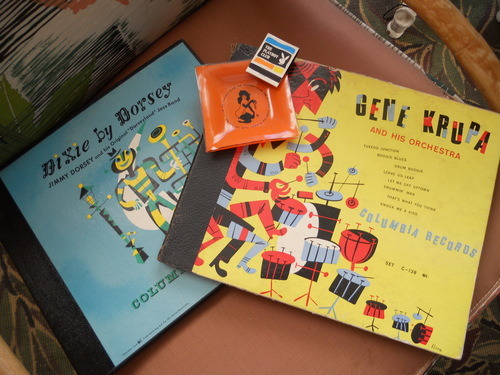The Art of Playboy

Let’s party with Jim Flora album art (shot in D. Hoekstra tiki bar)
Nov. 2, 2010—
While driving around with Playboy founder Hugh Hefner and his extended family during last week’s poignant hometown tour of Chicago, I mentioned the Oct. 24 passing of S. Neil Fujita to Hef.
Fujita (foo-JEE-ta), 89, was the graphic designer known for Miles Davis’ moody “Round About Midnight” album cover (photography by Marvin Koner) and the abstract design of Dave Brubeck’s “Time Out.” He also did the minmalist book cover for the Truman Capote classic “In Cold Blood.” I knew Hef is a jazz fan and who doesn’t love hot, stunning album art of the 1950s and 60s? Along with Fujita, Jim Flora’s ephemeral-tiki designs for Columbia and RCA are suitable for framing.

Thanks Neil.
“Jazz and rock music covers in the 1950s and 60s were the beginning of a graphic revolution,” Hef said as the tour bus tooled around the Galewood neigborhood where he grew up (as did actress Kim Novak, “I Dream of Jeannie’s” Bill Daily and American Breed drummer Lee Graziano—”Bend Me Shape Me”!)…Playboy was a dramatic part of that. People don’t recognize that Playboy changed the very nature of commercial art. Before Playboy, magazine illustrations were the Norman Rockwell realistic things. My art director Art Paul and I simply redefined the nature of commercial art.” Paul
designed the timeless Playboy rabbit-head logo.
Hefner and Paul had an unknown kindred spirit in Fuijta, a Hawaiian of Japanese ancestry.
Earlier this year The Design Observer Group reviewed Fujita’s “Aim for a Job in Graphic Design/Art,” published in 1968.
Fujita wrote: “Too many of us have been terribly insensitive to the things we touch, smell, taste, hear and see. We have forgotten how to feel, and so we take the next best avenue of approach to living. We intellecutalize the things we have failed to grasp with our sense…..Let’s dig into things and search what we personally feel is truth. Not truth in relation to accuracy manifested in acts and comprehended by feelings.
“As communicators, we should be the spokesmen of this truth….only then will we be able to make our efforts in print worthwhile to others.”
Amen.
When Hefner started Playboy in 1953 he deployed honest-to-the-core Chicago writers, artists and designers. They did not have New York pretension. “There was a pool of untapped talent here,” he told me. “The way we handled the cartoons gave the magazine a unique appearance. The full page full color thing was inspired by Esquire, but it got away from that. Esquire got frightened away from the post office (regulations). But beyond that, I hired commercial artists to become cartoonists so it gave the magazine a sophisticated look. My minor at the University of Illinois (Champaign) was art. There was always interesting graphics.”
I think the hometown visit [see my previous post here from my Chicago Sun-Times
blog, Hef Tweeted it, thank you….] was designed as a coming-of-age visit for Hefner’s sons Cooper, 19, and Marston, 20. I’m sure they will be back. They perked up when I told them stories of the Old Town Ale House as the bus headed down North Avenue.
Last year Hefner and the boys’ mother Kimberley sold their residence next to the Playboy Mansion for $18 milllion.
The five-bedroom, seven bathroom home built in 1929 was the place where Cooper and Marston grew up.
Cooper told me, “My Mom and Dad had houses parallel to each other, adjoined by a gate. So we grew up on both properties. Growing up wasn’t anything out of the ordinary. It was totally normal—until you grow up and are able to re-evaluate your situation and compare it to your friends. Then you realize you had something special. But, ‘What was it like playing with the monkeys?’ It was nothing special. You might go outside and mow the lawn and walk the dog. We’d go outside and feed monkeys.
“Marston has always been into video games. I loved making movies. I never went to the beach. I don’t like sand. It bothered my feet. I don’t know why. But we did the normal stuff. Obviously we had a big yard so we played games. I was telling someone the other day about how Nelly and Justin Timberlake were at the mansion. I was probably 11. Someone sent Marston and I to get autographs but I couldn’t figure out why I wanted an autograph. Don’t get me wrong, I was happy to meet Justin Timberlake and Nelly, but what was I going to do with a piece of paper? Or nudity was never a big deal. But when you bring a friend over and they see a naked picture, you wonder why its a big deal for them to look at boobs but not for us.”
They’ve been exposed to fine art all their lives.


Leave a Response